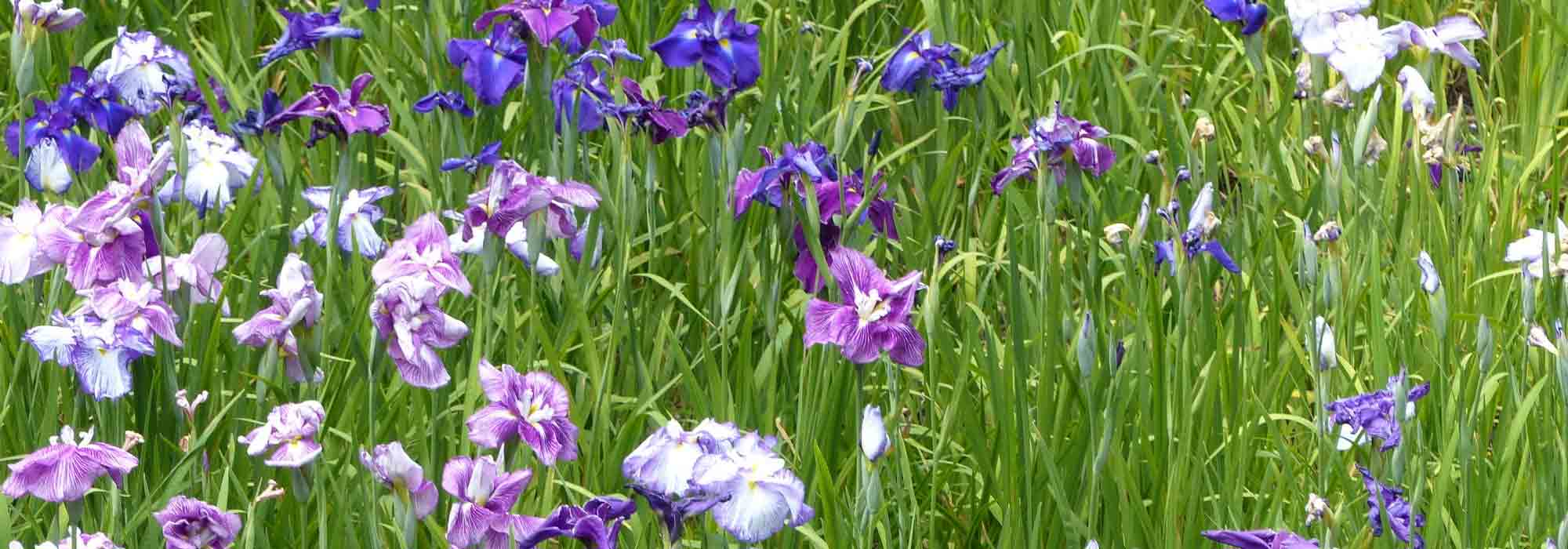
Japanese iris: to grow and care for
Contents
Japanese iris in a nutshell
- From May–June to August, Japanese iris offers exquisite flowering in ponds and water features
- Its graceful, highly stylised flowers are purple, blue, white or pink, delicately veined
- It prefers moist conditions but can also grow in ordinary, non-calcareous soil if not too dry
- Hardy, it copes very well with winter and slowly colonises space without requiring maintenance
- It is grown with its feet in water or in a cool, moist border
A word from our expert
Everyone knows Iris germanica, also called “garden iris” or Siberian iris, but do you know the Japanese iris or Iris japonica? Better known as Japanese iris, it is quite unlike those classic irises: it prefers cool to wet soils, is superb on pond edges, but also in beds that remain cool in summer.
Its flowering is lavish and opulent.
From Iris ensata to Iris laevigata variegata with variegated foliage, these water irises deserve wider planting as their large, veined flowers, mauve-violet, blue or white, all possess the refinement of Japanese floral art.
Hardy and easy to grow in soils that do not dry out in summer, Iris japonica is a plant for humus-bearing, rich, consistently moist soils.
Plant our Japanese iris in small groups in borders, cool rockeries or at the edge of your ponds: spectacular effect guaranteed!
And discover our perennials for moist banks to accompany them!
Description and botany
Botanical data
- Latin name Iris laevigata, Iris ensata
- Family Iridaceae
- Common name Japanese iris, Japanese water iris
- Flowering May to August
- Height 0.40 to 1 m
- Sun exposure Sun, partial shade
- Soil type moist
- Hardiness -15°C to -20°C
Japanese iris (Iris japonica), also known as “Japanese water iris” or “fringed iris”, is a perennial herbaceous rhizomatous plant of the Iridaceae family. Native to Asia, it grows in wet to marshy areas of Japan and China. The genus includes nearly 300 species divided between rhizomatous iris and bulbous iris.
Japanese iris belongs to the group of beardless irises within the so-called bearded irises. Among Japanese iris species, two are commonly found in gardens: Iris ensata (synonym kaempferi) or “shore iris” and Iris laevigata or “river iris”, which thrives in waterlogged soil and tolerates immersion very well. Both have given rise to numerous aquatic or semi-aquatic varieties and a multitude of cultivars in varied colours. Iris laevigata is another botanical species of marshy habitats. However, Japanese iris should not be confused with marsh iris, which bears exclusively yellow flowers.
There is also Iris × robusta, a hybrid resulting from the cross-breeding of Iris versicolor and Iris virginica.
Fast-growing, the plant forms in spring a dense clump with an erect habit, 25 to 80 cm tall in flower. It will spread thanks to its rootstock at soil surface, potentially reaching up to 4 m in spread at maturity, behaving almost like a groundcover and easily exceeding the space given to it.
Japanese iris reliably re-blooms year after year, managing to establish and naturalise where many other plants often fail to thrive. It usually becomes floriferous after three years in cultivation and has a fine lifespan of 5 to 20 years! The crown of Iris laevigata, thirsty for water, can spend the year with its feet in water.
Foliage is linear and deciduous. The fine, ribbon-like leaves tapering to a point, medium to bright green, measure 40 to 90 cm long. Some varieties, such as ‘Iris laevigata variegata’, are distinguished by bicoloured foliage striped white and green. Sheathing at the base and arranged in a fan, the leaves differ by species; marked by a prominent midrib in Iris ensata, they are absent in Iris laevigata.

Some Japanese iris flowers: Iris ensata ‘Dainagon’, Iris ensata ‘Comtesse de Paris’, Iris ensata ‘Darling’, Iris ensata ‘Variegata’
The highly branched flower stems rise from the centre of this somewhat stiff, bristly foliage. The precious, stylised flowering of Japanese iris evokes the finesse of orchids. From May–June to August, flowers appear, grouped two to four per stem, 8 to 12 cm in diameter at the top of the tall stems. Japanese iris have the largest flowers in the genus.
Wider than they are tall, these slender or round flowers consist of six broadly spatulate petals, delightfully fringed or sometimes crumpled: three small inner petals, thin and carrying a central ridge, sit above three wider, drooping outer sepals. The throat is maculated with a contrasting golden-yellow spot edged with white at the base of each sepal. Double-flowered cultivars exist.
They do not possess beards, those small coloured hairs at the base of the sepals characteristic of so-called bearded irises, as in garden irises.
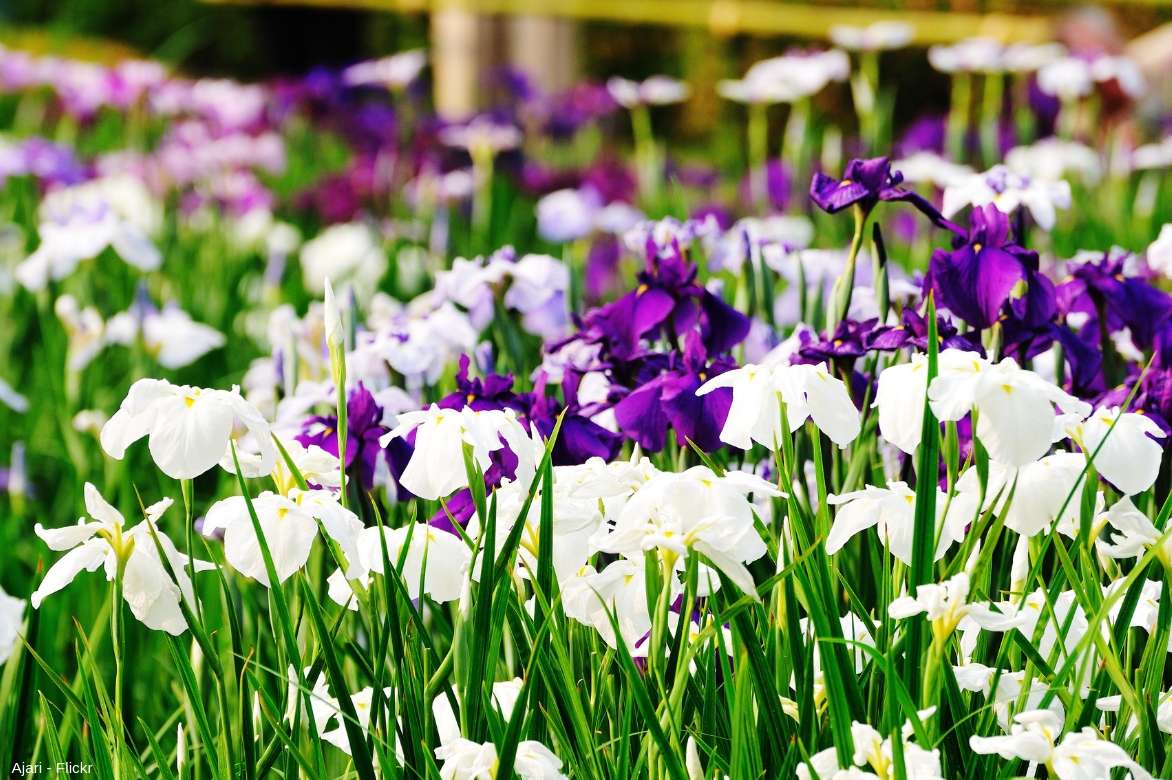
They come in an infinitely subtle palette of hues, displaying solid or bicoloured shades spanning all blues, from vivid violet to sky blue or lavender, as well as white, pale pink or purplish red. These large flowers present a delicate pattern that rewards close appreciation.
Translucent and velvety, the well-opened corollas are subtly streaked with darker veins. Marked with black, blue or violet, they reflect light gently.
The flowering, rather ephemeral in the first two years of cultivation, lasts about three weeks, but the quantity of flowers more than makes up for this.
These cut flowers, cultivated for centuries in Japan for ikebana, are stunning in fresh, slightly sophisticated bouquets.
Fruits are capsules filled with seeds.
With excellent hardiness down to -15°C to -20°C, Japanese iris can be planted widely. Unlike our garden irises, Japanese iris prefers moist, marshy, peaty, non-calcareous soil. It is best grown in sun, planted in large drifts in wet areas, moist borders and on pond or pool margins, or in large perforated pots submerged a few centimetres under water.
Read also
10 aquatic plants, submerged or floatingMain species and varieties
Les Japanese iris offer gardeners a wide range of uses. They are perennial plants for cool to moist soil, able to have their feet in water year-round for some, such as iris laevigata, or require cool soil in summer for others, like Iris ensata. All highlight wet areas around ponds and water features. Varieties offer a lovely subtle range of colours ranging from blue to pale pink through to white.

Iris robusta Dark Aura
- Flowering time July, August
- Height at maturity 90 cm
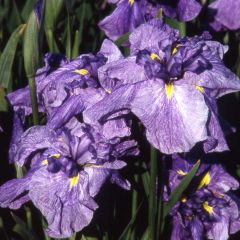
Iris ensata Dainagon - Japanese Water Iris
- Flowering time July, August
- Height at maturity 80 cm
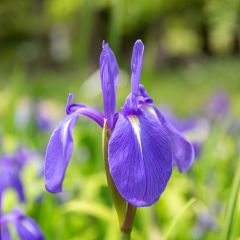
Iris laevigata - Water Iris
- Flowering time June to August
- Height at maturity 70 cm
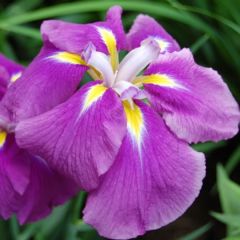
Iris ensata Sensation - Japanese Water Iris
- Flowering time July, August
- Height at maturity 90 cm
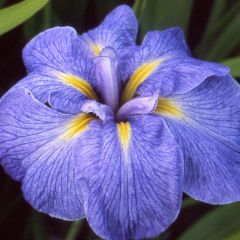
Iris ensata Mme Bigot - Japanese Water Iris
- Flowering time July, August
- Height at maturity 90 cm
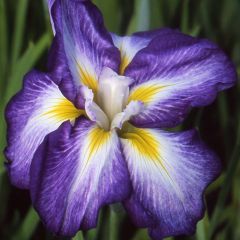
Iris ensata Illumination - Japanese Water Iris
- Flowering time July, August
- Height at maturity 1 m
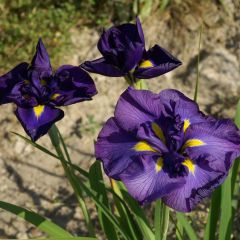
Iris ensata Geisha-Hiskiki - Japanese Water Iris
- Flowering time July, August
- Height at maturity 80 cm
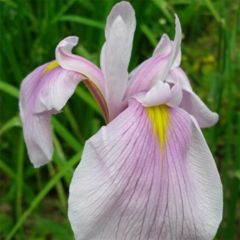
Iris laevigata Queen Victoria - Water Iris
- Flowering time July, August
- Height at maturity 70 cm

Iris ensata Comtesse de Paris - Japanese Water Iris
- Flowering time July, August
- Height at maturity 60 cm
Discover other Japanese Iris
View all →Available in 1 sizes
Available in 1 sizes
Available in 1 sizes
Available in 1 sizes
Available in 1 sizes
Available in 2 sizes
Available in 1 sizes
Available in 1 sizes
Available in 2 sizes
Available in 1 sizes
Planting
Where to plant Japanese iris?
Hardy to at least -15 to -20°C, Iris ensata and Iris laevigata offer good resistance to cold. They establish easily in the garden. These are marsh plants that enjoy moist, clayey or heavy soil but can be grown in any good garden soil provided moisture is sufficient.
If Iris laevigata tolerates having its feet in water even in winter, Iris ensata do not tolerate year-round immersion and prefer to keep feet dry during winter.
They appreciate lime-free soils and prefer slightly acidic soils.
Prefer planting them in full sun where they will be more floriferous, although light shade is tolerated. They need at least 6 hours of sun per day.
They are excellent for waterside plantings, for quickly covering pond banks, flowering on the borders of a pond or body of water. Iris laevigata can be planted shallowly below the surface, ideally at water level.
They are good plants for the most inhospitable parts of the garden, which they colonise easily as groundcover. Allow a minimum of space to accommodate their expansive nature.
They will thrive in beds, rockeries or cool borders, where they bring elegance and character. They are also much appreciated on a green wall.
→ Read also: How to plant and care for water irises?
When to plant Japanese iris?
Planting of Japanese iris is best done in autumn, from October to November for flowering the following summer and to allow rootstocks to establish well before winter. Planting is also possible in spring from February to April after the last frosts.
How to plant Japanese iris?
Mass planting in non-calcareous soil, slightly acidic, can be favoured. However, when the short flowering period ends, the planting may lose interest. Prefer planting in small groups of 3 to 5 plants per m² of the same variety to create attractive colour areas. Plant Japanese iris rootstocks in a staggered pattern for a natural effect.
Iris ensata can be planted 5 to 10 cm above water level; Iris laevigata can be immersed up to 10 cm deep.
In soil
- Dig a hole wide and deep enough to accommodate rootstocks
- Loosen soil to a good depth and width with a spade
- Clear stones and weeds
- Refill planting hole with extracted soil lightened with some heather soil and compost
- Bury rootstocks only lightly, 7 to 12 centimetres so they remain just below the surface
- Space them 25 to 40 cm apart
- Firm soil lightly
- Water to ensure soil adheres to roots, then water every 15 days to encourage rooting
How to plant Japanese iris with feet in water?
Planting at water level is ideal for Iris laevigata, a semi-aquatic perennial whose rootstocks tolerate shallow immersion very well.
- Place rootstocks in open pots filled with a mix of heather soil and garden soil
- Immerse each pot 2 to 10 cm deep maximum
- Maintain spacing of 25 to 40 cm between each plant
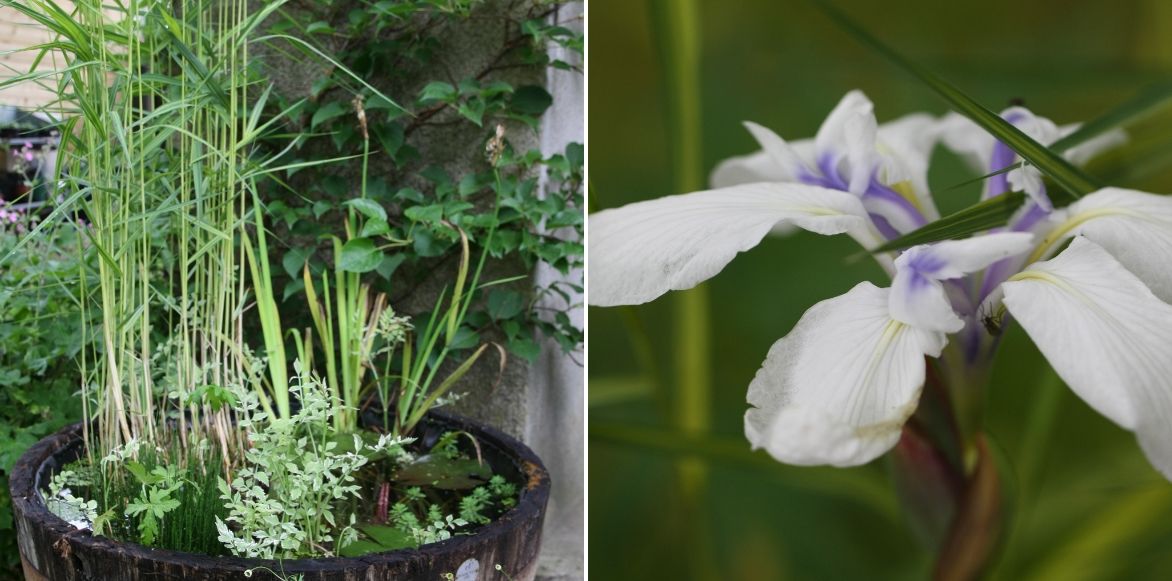
Iris laevigata ‘Snowdrift’ thrives in a basket with feet in water
Planting Japanese iris in pots
Japanese iris adapts perfectly to container culture. It is even easier to meet its requirements: permanent moisture in summer and feet kept dry in winter.
- Make a draining layer at pot base
- Plant in a mix of garden soil, turf, heather soil and well-rotted compost
- Place in sun
- Water so soil never dries out
Maintenance, pruning and care
Care of Japanese iris is minimal because it is a flower that requires very little care. It simply has high water requirements!
To keep Japanese iris looking good for a long time, and especially iris ensata, follow a simple rule: keep soil cool to moist before and after flowering, but ensure their base stays dry through good drainage during winter dormancy.
It will become more drought-resistant after flowering.
A little surface compost will keep substrate moist in summer.
Remove faded flowers before they produce seeds that could self‑sow beyond intended area…
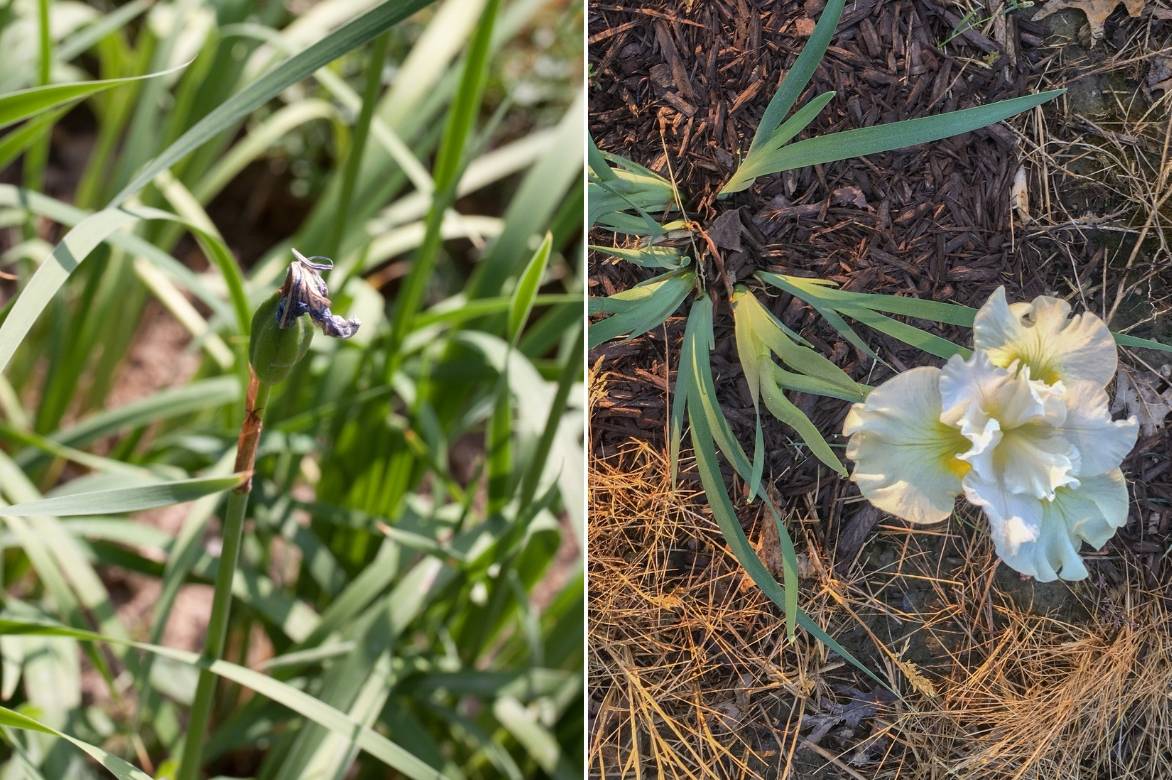
Faded Japanese iris, seed production / divide clumps every 3 or 4 years (photo F.D. Richards – Flickr)
Cut yellowing leaves that look untidy in a border. Weed the centre of clumps regularly.
In autumn and spring, scatter one or two shovelfuls of compost and turf over clumps.
Every 3–4 years, divide clumps: rootstocks that are too crowded will be noticeably less floriferous.
Potential diseases and pests
L’Japanese Iris est virtually disease-free. L’Iris ensata needs to be kept dry in winter: overly wet soil favours rootstock rot. Ensure stumps are above water in winter.
Slugs and snails can attack young shoots in spring: discover our solutions to deter them.
Multiplication
When and how to divide Japanese Iris?
Japanese Iris is a stoloniferous iris that multiplies easily by division of rootstocks. Dividing Japanese iris also rejuvenates clumps. Do this from July to October. Sowing is tedious and lengthy.
- Remove dead leaves and herbs from centre of clump
- Lift the clump with a digging fork
- Remove old rootstocks with a sharp knife
- Separate the rootstocks from each other
- Trim the foliage slightly before replanting them immediately in full sun in well-prepared soil
Combining Japanese irises
Precious, stylised flowers of Japanese Iris are indispensable in a natural garden to bring graphic, colourful and graceful touches to pond edges or to festoon a border or a cool rockery. They highlight wet areas around water features.
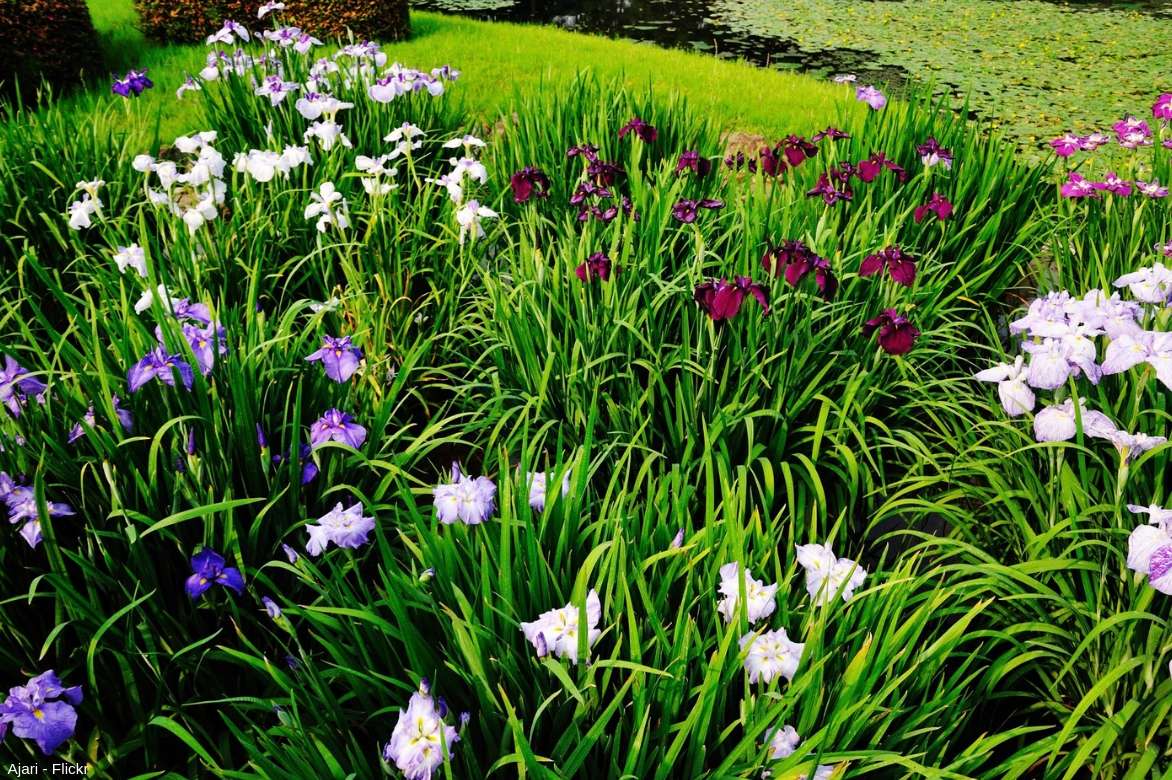
Feel free to vary colours as on the edge of this pond!
Japanese Iris pairs well with aquatic perennials, in white/blue colour schemes with Astilbes or blue/yellow, especially with the yellow flowers of Caltha palustris.
It is a good companion for Meconopsis with exquisite flowers and for small groundcover plants such as Veronica beccabunga, creeping bugle or heucheras.
It is enhanced alongside green-yellow or white foliage and flowers of hostas, Equisetum, Candelabra primulas, euphorbias, ligularias, lysimachias.
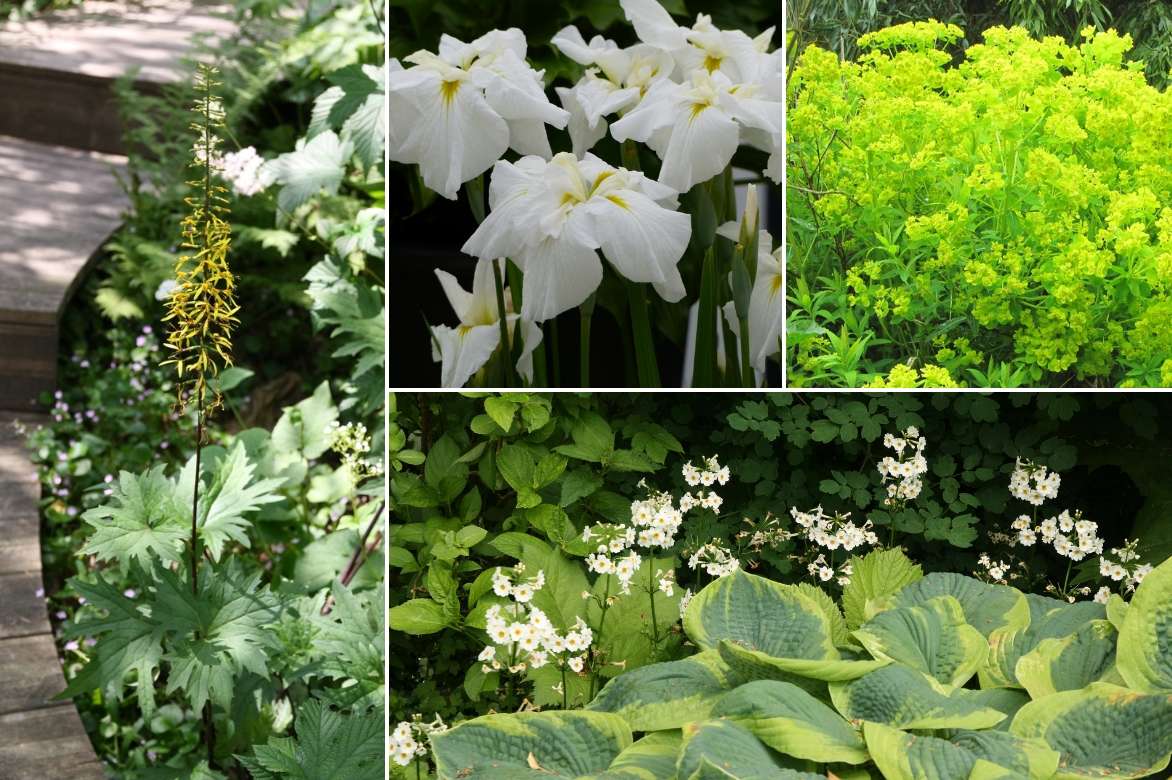
An idea for a planting in moist to wet soil: Ligularia przewalskii, Iris ensata ‘Gold Bound’ (a variety similar to ‘Comtesse de Paris’, a little smaller), Euphorbia palustris, Hosta sieboldiana ‘Frances Williams’ and Primula japonica ‘Alba’
Anemones rivularis, Physostegia virginiana will also be good companions for a cool, moist medium.
It will provide an inspired contrast with the flamboyant colours of daylilies.
Useful resources
- Discover our wide range of Iris!
- Get inspired by our ideas for aquatic plants to add blooms to a pond!
- Discover our selection of iris by colour: 9 superb water irises with blue flowers, 7 water irises with captivating violet and purple flowers, 7 water irises with pink flowers to enchant wetland areas and top 7 most beautiful water irises with bicolour or multicolour flowers.
- Our tutorial : How to propagate water irises?
- Subscribe!
- Contents
































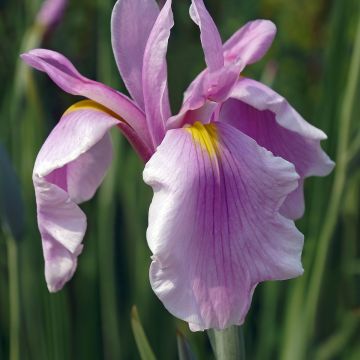
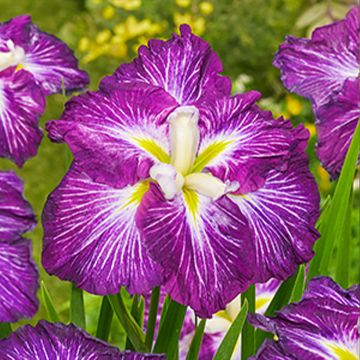
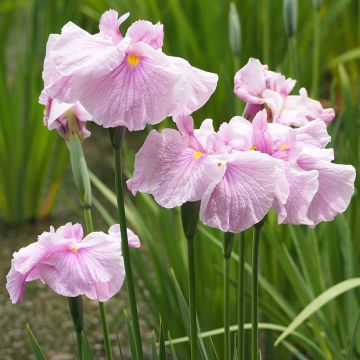


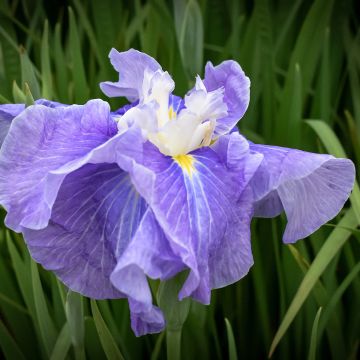
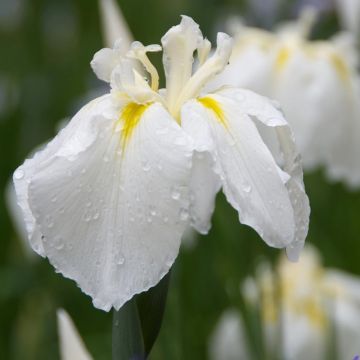
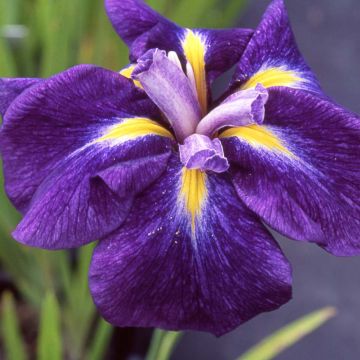
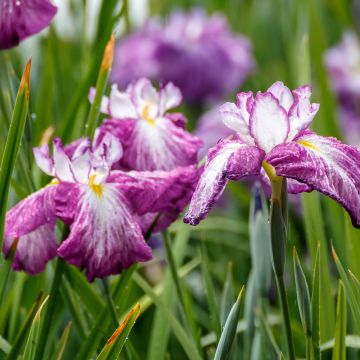
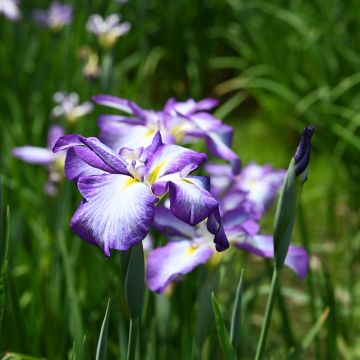
Comments